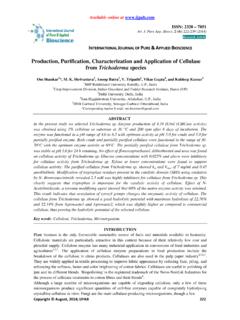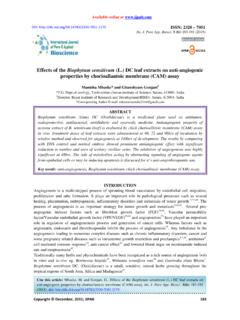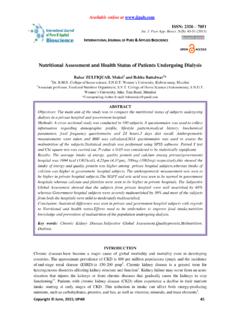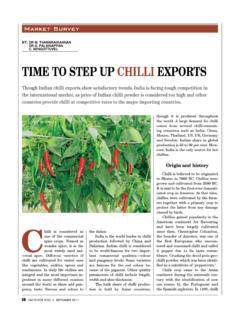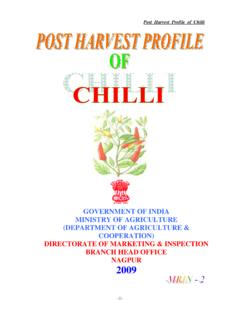Transcription of Chilli Leaf Curl Virus an Emerging Threat to Chilli in India
1 Zehra et al Int. J. Pure App. Biosci. 5 (5): 404-414 (2017) ISSN: 2320 7051 Copyright , 2017; IJPAB 404 Chilli Leaf curl Virus an Emerging Threat to Chilli in India Syed Berjes Zehra1, Asif Ahmad2, Abhishek Sharma5, Shakeela Sofi3, Azra Lateef1, Zaffar Bashir3*, Mohit Husain4 and Jagdeeh Prasad Rathore5 1 Department of Vegetable sciences, 2 Department of Plant Pathology, 3 Department of Microbiology, 5 Division of Fruit Science 4 Faculty of Forestry, Benhama-Ganderbal, 5 Department of vegetable sciences (PAU-Ludhiana) Sher-e-Kashmir University of Agricultural Sciences and Technology of Kashmir, Shalimar-190025 *Corresponding Author E-mail: Received: | Revised: | Accepted: INTRODUCTION Chilli (Capsicum annuum L.)
2 Is an important spice grown for its fruits, which are used in green as well as ripe dried form for its pungency. Chilli belongs to the genus Capsicum, family Solanaceae. It has originated in Mexico, Southern Peru and Bolivia71. There are mainly five cultivated Capsicum spp. viz. C. annuum, C. baccatum, C. chinense, C. frutescens, and C. pubescens. Available online at DOI: ISSN: 2320 7051 Int. J. Pure App. Biosci. 5 (5): 404-414 (2017) ABSTRACT Chilli is known to be affected by forty five viruses. Twenty four of them have been reported to occur naturally and rest can infect on artificial inoculation. Among the twenty four viruses reported to occur naturally on Chilli , eleven viruses have been reported from India . Among all, the Chilli leaf curl Virus is the most destructive Virus in terms of incidence and yield loss.
3 In severe cases 100 percent losses of marketable fruit have been reported. Chilli leaf curl locally known as murda is a most destructive disease of Chilli in India . However, the viral nature of the disease has not been proved experimentally until Ashrafi Jha from IARI established this by grafting, later it was proved that leaf curl of Chilli is caused by tobacco leaf curl Virus (Ruga tabaci) which is transmitted by vector B. tabaci. The diseases caused by begomoviruses are easily recognized by their distinctive symptoms in plants infected with these viruses. The symptoms are broadly of three types: a) vein yellowing, b) yellow mosaic and c) leaf curl . Control of ChiL CV viruses by chemicals or cultural management practices has not been very effective. The planting of resistant cultivars offers the best way to control these viruses.
4 A number of sources of Virus resistance have been reported in wild and cultivated lines and several Virus -resistant lines have already been released. Many multiple Virus -resistant varieties have been developed at Punjab Agricultural University, Ludhiana. Important multiple resistant lines are Perennial, BG-1, Lorai, and Punjab Lal. Weeds act as potential sources of begomoviruses, several weed families particularly Malvaceae have been found to harbor viruses. Key words: Chilli leaf curl , begomo viruses and B. tabaci and management. Review Article Cite this article: Zehra, , Ahmad, A., Sharma, A., Sofi, S., Lateef, A., Bashir, Z., Husain, M. and Rathore, , Chilli Leaf curl Virus an Emerging Threat to Chilli in India , Int. J. Pure App. Biosci. 5(5): 404-414 (2017). doi: Zehra et al Int.
5 J. Pure App. Biosci. 5 (5): 404-414 (2017) ISSN: 2320 7051 Copyright , 2017; IJPAB 405 Among these, C. annuum L. is the most widely cultivated species all over the world for its pungent ( Chilli syn. Hot pepper) and non-pungent (sweet pepper) fruits. Chilli crop is raised over 1832 thousand hectares in the world, with a production of 2959 thousand tonnes4. Highest production per unit area of 36,585 kg per ha was recorded in Japan4. It was first introduced in India by Portuguese towards the end of 15th century. The top ten Chilli producing countries India , China, Ethiopia, Myanmar, Mexico, Vietnam, Peru, Pakistan, Ghana and Bangladesh accounted for more than 85% of the world production in 2009; lion s share is taken by India with 36% share in global production, followed by China (11%), Bangladesh (8%), Peru (8%) and Pakistan (6%) India Chilli is cultivated in all the states including Andhra Pradesh, Karnataka, Maharashtra, Orissa, Rajasthan, Tamil Nadu, West Bengal and Punjab over an area of 804790 hectares with total production of 1276300 metric tonnes of dry Chilli with productivity of metric tonnes per hectare.
6 Andhra Pradesh alone contributes 46 per cent of total Chilli production of India . India contributes one-fourth of the total quantity of Chilli exported in the foreign exchange is being earned through export of Chilli powder, oleoresin of low, medium or high pungency. At present 169500 quintals of dry Chilli of the worth of Rs 160408 lakh is exported from the country4. Indian chillies are exported to over 90 countries in the world4. If some varieties are famous for red colour because of the pigment capsanthin, others are known for biting pungency attributed by capsaicin. It is a rich source of vitamins A and C. India is the only country rich in many varieties with different quality factors. World s hottest Chilli Naga Jolokia is cultivated in hilly terrains of Assam in a small town Tezpur, India4.
7 Chilli is known to be affected by forty five viruses20. Twenty four of them have been reported to occur naturally and rest can infect on artificial inoculation. Among the twenty four viruses reported to occur naturally on Chilli , eleven viruses have been reported from India , viz., cucumber mosaic Virus , tobacco leaf curl virus25, Indian Chilli mosaic Virus , potato Virus Y, potato Virus X, tobacco ring spot Virus , pepper veinal mottle Virus and pepper vein bending Virus , Chilli leaf curl Virus , tomato leaf curl New Delhi virus30, capsicum chlorosis Virus a tospo Virus . Recently cucumber mosaic Virus subgroup II has been reported to infect chilli6 from western Himalayan region of India . In Mexico, two Gemini viruses are considered to be the main pathogens in pepper pepper huastico Virus (PHV) and pepper golden Mosaic Virus (PepGMV) formerly called texas pepper Virus .
8 Among all, the Chilli leaf curl Virus is the most destructive Virus in terms of incidence and yield loss. In severe cases 100 percent losses of marketable fruit have been reported33. Chilli LEAF curl Virus The etiology of chili leaf curl disease was reported during the 1960s13. Since it is a begomovirus and it is transmitted in a persistent manner by white flies of the species complex Bemisia tabaci7. The typical symptoms consisting of leaf curling, rolling, puckering, blistering of interveinous areas and thickening and swelling of the veins, shortening of internodes and petioles, crowding of leaves and stunting of whole plants, older leaves may become leathery and brittle60. Chilli leaf curl locally known as murda is a most destructive disease of Chilli in India .
9 The etiology of chili leaf curl disease was reported during the 1960s13. Mites (Polyphagotarsonemus latus)) and thrips (Scirtothrips dorsalis) were considered to be responsible for causing Chilli leaf curl symptoms42. Johnpulle28 considered it to be caused by both mites and thrips. Amin3 concluded that leaf curl in Chilli was due to feeding of thrips and mites and not by an infectious agent. However, the viral nature of the disease has not been proved experimentally until Ashrafi Jha from IARI in 1953 established this by grafting, later it was proved that leaf curl of Chilli is caused by tobacco leaf curl Virus (Ruga tabaci) which is transmitted by vector B. tabaci56. Zehra et al Int. J. Pure App. Biosci. 5 (5): 404-414 (2017) ISSN: 2320 7051 Copyright , 2017; IJPAB 406 Based on partial DNA-A sequences, a monopartite begomovirus was reported to be associated with the disease which was a strain of the Chili leaf curl Virus (ChiLCV) from Pakistan 30.
10 VARIABILITY IN BEGOMOVIRUSES INFECTING Chilli There has been a tremendous increase in the number of begomoviruses that have been isolated in recent years as these are assumed to have been co-evolving with their dicotyledonous plant hosts for a long time54. Currently, 35-70 geminiviruses are being discovered and characterized every year. Out of the total geminiviruses, 200 defined species belong to begomoviruses, thus making it the largest genus in the family. So far, 34 recognized and 18 tentative species of begomoviruses have been found to naturally infect tomato. However, the begomoviruses with generic name tomato leaf curl viruses are the most devastating viruses. In India , eight different viruses cause Tomato leaf curl disease (ToLCD). Three of these viruses, tomato leaf curl Gujarat Virus (ToLCGV), tomato leaf curl India Virus (ToLCIV) and tomato leaf curl New Delhi Virus (ToLCNDV) occur in northern India while the other two, tomato leaf curl Bangalore Virus (ToLCBV) and tomato leaf curl Karnataka Virus (ToLCKV) occur in southern India38.
